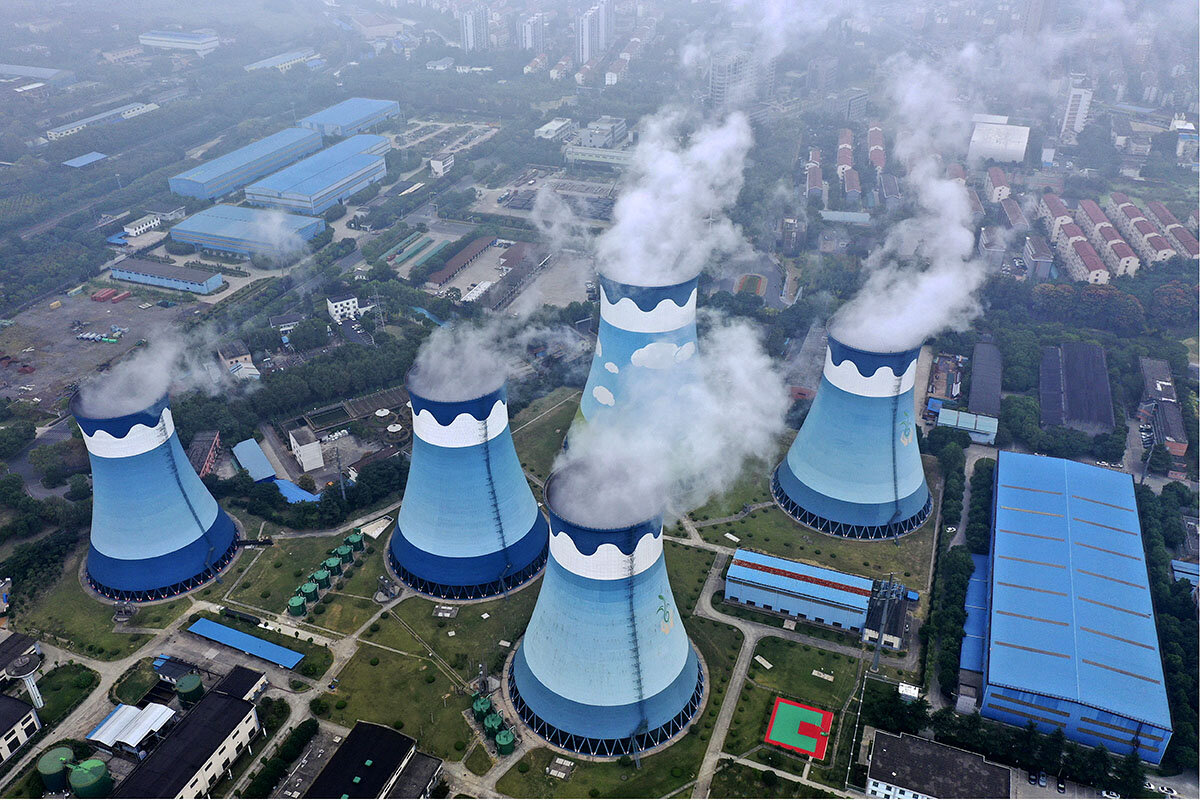Will China’s energy crisis dampen its effort to cut emissions?
Loading...
| Seattle
Liu Rui, a university student in Tonghua, a city in Jilin province, felt anxious. A sudden, widespread power outage across northeastern China had left her family without electricity to cook or heat water, and her laptop’s battery was running out before an online class.
“I was always worried the internet would suddenly disconnect during class,” says Ms. Liu by email, using a pseudonym to protect her privacy. She describes her neighborhood’s darkened streets and shops, and feeling like a thief going through a dimmed supermarket looking for frozen steamed buns – only to find no buns and the freezer shut off.
Thousands of miles south in China’s Guangdong province, factory owner Zhang Hong faced a similar dilemma. Her printed circuit-board factory, part of China’s vast ecosystem of electronics manufacturing, had been ordered in late September to shut down for four days a week, hurting output and workers’ income. “Government staff will notify us whether work can start the next day,” she says, speaking on condition her real name be withheld.
Why We Wrote This
China will play a key role in whether the world can curb global warming. But it’s also an industrial powerhouse, and recent electricity shortages reveal challenges ahead in balancing economic and environmental goals.
Across China, the worst power shortages in a decade have in recent months led to electricity rationing in most provinces – disrupting daily life and factory output, dampening the economy, and exacerbating supply chain disruptions around the world. The shortages arose when soaring domestic demand for coal ran up against government controls on electricity prices and usage, and on coal imports.
To boost power output, Beijing has responded with a major push to increase coal production and power generation, as well as with a significant easing of controls on electricity prices. But as world leaders meet at the United Nations Climate Change Conference in Glasgow, Scotland, to try to tackle greenhouse gas emissions that have already raised average global temperatures by over a degree Celsius from preindustrial levels, all eyes are on China, the world’s largest polluter and second-largest economy.
With 1.4 billion people and a growing economy dominated by energy-intensive heavy industry, China is indispensable to any collective action on global warming. But this summer’s energy crunch has highlighted the scale of the challenge in breaking its reliance on coal and other fossil fuels.
China has pledged that its emissions will peak by about 2030, and it will reach carbon neutrality by 2060. But details of exactly when and at what level emissions will peak are lacking. And a statement by Premier Li Keqiang last month led some analysts to wonder whether the current power crisis was leading Beijing to rethink the timeline.
China must “take into account the recent situation of dealing with the contradiction between the supply and demand of electricity and coal ... and put forward the timetable and road map of the steps to reach the peak of carbon,” Mr. Li said, according to the state-run Xinhua news agency.
A dependence on coal power
So far, energy experts say the power shortages appear to be propelling changes that could both hurt and benefit China’s carbon emission reduction efforts.
“There are ... voices and interests in China that are trying to use this crisis to attack China’s climate targets and ambitions, and to emphasize how important it is to increase supply of fossil fuels,” says Lauri Myllyvirta, lead analyst at the Centre for Research on Energy and Clean Air, an independent research group in Helsinki.
Meanwhile, “some of the measures taken already also benefit clean energy – for example, the measures that create incentives for businesses to produce green electricity,” he says. “It’s too early to say which of these responses will win out.”
China’s power shortages underscore its dependence on coal, which supplies around 60% of its energy needs, even as renewable and nuclear energy capacity grows much faster. The country is home to nearly half of the world’s coal-fired power plants.
The main source of China’s current power crisis, experts say, is a mismatch between demand and supply. Demand for coal has surged, especially in construction and heavy industry, during an economic recovery from the 2020 pandemic slowdown. This in turn pushed up the market price of coal. Meanwhile, because government caps on electricity prices made it unprofitable for power generators to operate, many closed down.
“Coal is now expensive and ... generators are unable to recoup their costs,” says David Fishman, a manager at The Lantau Group, an energy consultancy. “So they stopped generating. They stopped producing power,” he says. “Most everywhere [in China] is affected.”
Some provinces also rationed power supplies in order to meet annual controls set by Beijing on their energy consumption and efficiency – known as the “dual control” mechanism. Adverse weather also caused drops in output of hydropower and wind power in southwest and northeast China, respectively. Finally, China has stopped buying Australian coal after its government last year called for an independent investigation into the origins of COVID-19.
Power rationing continues to hobble many manufacturers. In Guangdong, for example, Ms. Zhang’s circuit board factory has cut production and wages by a third. The factory is allowed to operate at night when power consumption is lower, but her 70-odd workers are reluctant to take night shifts, she says. “My biggest concern is the duration of the power rationing,” she says, adding that she hopes it will be temporary.
Guangdong is China’s biggest manufacturing hub, and stoppages at thousands of factories like Ms. Zhang’s are worsening supply chain bottlenecks for finished goods using electronics – from cars and toys to computers and household appliances.
Dual controls on energy
Beijing’s response to the energy crisis could offer clues to the country’s long-term goal of reducing carbon emissions, experts say.
To boost power generation ahead of winter, China has ordered the reopening of some closed coal mines and power plants, while delaying taxes for the power industry. It has also signaled an easing of the dual controls on energy use and energy efficiency, and warned localities against suspending production or limiting carbon emissions in a “disorderly” way. That is likely to send Chinese emissions spiking in the short term, just as the world grapples with the dilemma of how to cut more quickly by 2030 so as to avert the severest effects of climate change.
But it’s not all downside: Beijing has also ordered price reforms in a market liberalization that could make renewable energy alternatives more attractive compared with coal. Last month, Beijing allowed electricity prices from coal-fired power plants to rise as much as 20% for industrial and commercial users, and removed the price cap completely for energy-intensive industries. More expensive coal-produced electricity could prove a boost for competing sources of clean power.
“Stripping away coal’s protections and forcing it to compete in a market against other types of power – which are at the moment cheaper than coal – is not good for coal,” says Mr. Fishman. “It’s good for your low-carbon generation sources.”
Beijing has also called for the construction of more large-scale wind power and solar power generation projects to raise their capacity to a total of 1,200 gigawatts by 2030. In September, President Xi Jinping told the U.N. General Assembly that China would finance more low-carbon energy projects overseas, while ending its funding for coal power plants.
Yet ultimately, experts say, only when China announces a more detailed plan for reaching peak carbon emissions before 2030 will the impact of the current power crisis on the country’s willingness to reduce its dependence on coal become clearer.
“There is still quite a lot of wiggle room ... in China’s commitment for the next couple of decades,” says Mr. Myllyvirta. “The specific emissions pathway that China follows ... is incredibly important.”







